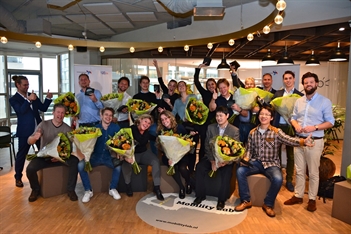Case study Marketplace for Mobility Rotterdam
The Marketplace for Mobility is a measure enacted under the Optimising Use implementation programme run by De Verkeersonderneming, a public-private partnership involving Rijkswaterstaat and the city of Rotterdam, among others. By linking private parties (some in partnerships) with mobility needs to private providers of mobility services through a central marketplace, we can create new and better solutions for avoiding peak-time traffic.
This will eventually have a greater impact on regional accessibility than individual projects undertaken by various parties. In addition, it serves as a precursor to Mobility as a Service (MaaS).
Private parties invest a great deal of money in mobility, for their clients, visitors and employees, for example. Many of those resources could be more effectively deployed by partnering with others. That was the basic premise in establishing the Marketplace for Mobility. De Verkeersonderneming wants to make market players in the region aware of this and provide them with active support.
The project
This support consists of actively linking parties with mobility needs to providers of suitable new or existing mobility services. De Verkeersonderneming acts as a market superintendent in this process. It mobilises its extensive network to match the demand for mobility solutions in the region to the supply from market players. In doing so, moreover, De Verkeersonderneming also provides a platform through which mobility providers can introduce their services to the market.
The Marketplace for Mobility is part of a broader regional approach taken by De Verkeersonderneming. Under this strategy, the various measures enacted reinforce one another. This makes it easier for the marketplace services to have effect. Conversely, the new services offer additional opportunities for inducing behavioural change in the region.
In the latest call for tenders, De Verkeersonderneming decided not to have all the services (market players) operate individually, but rather to ask participants to apply as a consortium. The parties can then operate multiple services, such as shared bike schemes, collective transport and public transport, on a single platform as part of the consortium. This is also a first step toward Mobility as a Service (MaaS), in which the consumer no longer buys modes of transport but rather contracts mobility (see also the Case study MaaS from the Toolbox).
Implementation
There have now been three rounds of tenders. In the first round for the Marketplace (started in 2011-2012), mobility services were sought for meeting two objectives: to achieve rush-hour avoidance and to experiment more broadly with innovative mobility services. In the second round for the Marketplace for Mobility (started in 2015), the focus was solely on attaining rush-hour avoidance.
In the third round, the emphasis was on the formation of consortia made up of multiple parties that could lay out a more complete package of services for travellers and employers. In addition, the Mobility Lab was established to provide a space for start-ups to test new mobility services.
The market players and consortia submitting bids for the Marketplace could set their own targets for how much rush-hour avoidance they might achieve. More importantly, they had to show, with their business case, that the operation would break even within three years. In the second round, the tenders had to also incorporate certain features associated with the concept of Mobility as a Service (MaaS). The third round took further steps in the direction of MaaS.
In all, 34 vendors were selected. They received 50 per cent co-funding for the first three years from the Optimising Use programme, on the condition that they actually achieved the level of rush-hour avoidance they had indicated in their bid. De Verkeersonderneming also offered them use of its network for finding customers for the mobility service in question. Furthermore, the winning vendors could immediately piggyback on all the marketing communications by De Verkeersonderneming, including the 'Filedier' (traffic jam animal) mobility campaign.
Results
The Marketplace for Mobility demonstrates that it is possible for the government to identify mobility problems and challenges and then stimulate the market in such a way that it tackles the problems without the need for structural public co-funding. Moreover, it has since become clear that the Marketplace also contributes to the further development of Mobility as a Service in the region. For details on the effects achieved, see the Marketplace for Mobility fact sheet.
Considerations for deployment elsewhere
There are a number of points for consideration and lessons learned with regard to the Marketplace for Mobility:
- Since there was a need for many different mobility solutions, many 'winners' were chosen and that also entailed concluding many contractual arrangements with these parties. That was a great deal of administrative work without necessarily the same level of returns.
- Establish a Marketplace for Mobility primarily for rush-hour avoidance, on a larger scale with proven mobility services. It appears to be more effective to decouple objectives in terms of innovation and diversity from that goal and place these under another programme, such as a Mobility Lab.
- In addition to the economic aspects of mobility (rush-hour avoidance, decreasing congestion), be sure to think about the social aspects (e.g., social return on investment).
- It appears that market players can indeed be stimulated to collectively undertake mobility management measures without any co-funding from the government, structural or otherwise.

